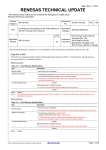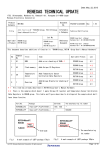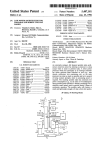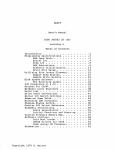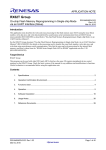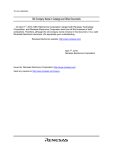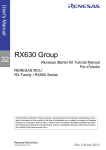Download RX630 Group Application Note Reducing Power Consumption
Transcript
APPLICATION NOTE RX630 Group Reducing Power Consumption R01AN1293EJ0100 Rev. 1.00 Apr. 1, 2014 Abstract This document describes a method of reducing power consumption for the RX630 Group. Products RX630 Group When using this application note with other Renesas MCUs, careful evaluation is recommended after making modifications to comply with the alternate MCU. R01AN1293EJ0100 Rev. 1.00 Apr. 1, 2014 Page 1 of 14 RX630 Group Reducing Power Consumption Contents 1. Using the Module-Stop Function to Reduce Power Consumption ..................................................... 3 1.1 Peripheral Modules That Support the Module-Stop Function...................................................... 3 1.2 Peripheral Modules That Do Not Support the Module-Stop Function ......................................... 3 1.2.1 Settings When Not Using the Realtime Clock ...................................................................... 3 1.2.2 When Not Using the Voltage Detection Circuit ..................................................................... 3 2. Controlling Clocks to Reduce Power Consumption ........................................................................... 4 2.1 Operating and Stopping Clocks ................................................................................................... 4 2.2 Clock Frequencies ....................................................................................................................... 4 2.3 Power Supply for the HOCO ........................................................................................................ 4 2.4 Operating Power Consumption Control Modes ........................................................................... 4 2.4.1 High-Speed Operating Mode ................................................................................................ 4 2.4.2 Low-Speed Operating Mode 1 .............................................................................................. 4 2.4.3 Low-Speed Operating Mode 2 .............................................................................................. 4 2.5 Correspondence Between the Operating Frequency and the Operating Power Consumption Control Modes ........................................................................................................................................... 4 3. Using Low Power Consumption Modes to Reduce Power Consumption .......................................... 5 3.1 Low Power Consumption Modes ................................................................................................. 5 3.1.1 Sleep Mode ........................................................................................................................... 5 3.1.2 All-Module Clock Stop Mode ................................................................................................ 6 3.1.3 Software Standby Mode ....................................................................................................... 7 3.1.4 Deep Software Standby Mode .............................................................................................. 9 3.2 Correspondence Between the Time for Returning From a Low Power Consumption Mode and Power Consumption ................................................................................................................................ 11 3.3 Notes on Using Low Power Consumption Modes ..................................................................... 12 3.3.1 DMAC and DTC Status When Transitioning to a Low Power Consumption Mode ............ 12 3.3.2 BCLK Output When Using a Low Power Consumption Mode............................................ 12 3.3.3 Transitioning to a Low Power Consumption Mode During D/A Conversion ....................... 12 3.3.4 Transitioning to a Low Power Consumption Mode During A/D Conversion (S12AD and AD Modules) 12 3.3.5 Transitioning to a Low Power Consumption Mode During Data Transmission/Reception (SCI) 12 4. Other Processing .............................................................................................................................. 13 4.1 Handling of Unused Pins ........................................................................................................... 13 5. Reference Documents ...................................................................................................................... 14 R01AN1293EJ0100 Rev. 1.00 Apr. 1, 2014 Page 2 of 14 RX630 Group 1. Reducing Power Consumption Using the Module-Stop Function to Reduce Power Consumption The RX630 Group has a module-stop function that stops the supply of clocks to peripheral modules. Power consumption can be reduced by putting peripheral modules that are not used in the module-stop state. 1.1 Peripheral Modules That Support the Module-Stop Function The module-stop can be set with module stop control registers (MSTPCRA to MSTPCRC) for each peripheral module. After a reset is canceled, all peripheral modules other than the DMAC, DTC, and RAM are placed in the module-stop state. Transition these modules to the module-stop state as needed. DMAC/DTC – Set the MSTPCRA.MSTPA28 bit to toggle the module-stop state. RAM0 – Set the MSTPCRC.MSTPC0 bit to toggle the module-stop state. RAM1 – Set the MSTPCRC.MSTPC1 bit to toggle the module-stop state. 1.2 Peripheral Modules That Do Not Support the Module-Stop Function Some peripheral modules do not support the module-stop function. When not using these peripheral modules, their operation should be stopped. 1.2.1 Settings When Not Using the Realtime Clock As registers in the realtime clock (RTC) are not initialized after a reset, values after a reset may cause unintentional interrupt requests to be generated, or as counters are operating, power consumption may increase. When not using the RTC, follow the initialization process described in the user's manual to initialize the registers. 1.2.2 When Not Using the Voltage Detection Circuit When not using the voltage detection circuit (LVD), set bits LVCMPCR.LVD1E and LVD2E to 0 (voltage detection 1 circuit disabled, and voltage detection 2 circuit disabled, respectively). R01AN1293EJ0100 Rev. 1.00 Apr. 1, 2014 Page 3 of 14 RX630 Group 2. Reducing Power Consumption Controlling Clocks to Reduce Power Consumption 2.1 Operating and Stopping Clocks Power consumption can be reduced by stopping as many of the following as possible – main clock oscillator, sub-clock oscillator, high-speed on-chip oscillator (HOCO), low-speed on-chip oscillator (LOCO), PLL circuit, and IWDTdedicated on-chip oscillator. Refer to the user's manual for notes on stopping clocks. 2.2 Clock Frequencies Power consumption can be reduced by lowering the frequencies of the following clocks – system clock (ICLK), peripheral module clock (PCLKB), external bus clock (BCLK), and the flash interface clock (FCLK). When clocks are not used (e.g. when not using the external bus), power consumption can be reduced by setting the frequency division ratio to 64 (the maximum frequency division ratio). 2.3 Power Supply for the HOCO Set the HOCOPCR.HOCOPCNT bit to 1 to turn off the power supply of the HOCO. 2.4 Operating Power Consumption Control Modes Power consumption can be reduced by selecting an appropriate operating power consumption control mode according to the clock, operating frequency, and operating voltage. The three operating power control modes in the RX630 Group are high-speed operating mode, low-speed operating mode 1, and low-speed operating mode 2. When transitioning to another mode, follow the procedure in the user's manual in section 11.5.1 Setting Operating Power Consumption Control Mode to set the OPCCR register. 2.4.1 High-Speed Operating Mode 2.4.2 Low-Speed Operating Mode 1 This mode allows high-speed operation. After a reset cancellation or recovery from software standby mode, the LSI is activated in this mode. Use the high-speed operating mode when a clock faster than 1 MHz is necessary. This mode consumes less power than the high-speed operating mode. In this mode, ICLK, FCLK, PCLKB, and BCLK operate at 1 MHz or less. The PLL and HOCO cannot be used. Set the PLLCR2.PLLEN bit to 1 (PLL is stopped) and set the HOCOCR.HCSTP bit to 1 (HOCO is stopped). Program and erase operations of the flash memory are disabled. 2.4.3 Low-Speed Operating Mode 2 This mode consumes even less power than low-speed operating mode 1. In low-speed operating mode 2, the ICLK, FCLK, PCLKB, and BCLK operate at 125 kHz or less, and the minimum operating frequency of the ICLK and FCLK is 32 kHz. The PLL and HOCO cannot be used. Set the PLLCR2.PLLEN bit to 1 (PLL is stopped) and set the HOCOCR.HCSTP bit to 1 (HOCO is stopped). Program and erase operations of the flash memory (ROM, E2 DataFlash) are disabled, and the E2 DataFlash cannot be read. 2.5 Correspondence Between the Operating Frequency and the Operating Power Consumption Control Modes Table 2.1 lists the operating power consumption control modes and their maximum operating frequencies. Select an operating power consumption control mode appropriate to your operating frequency needs. Table 2.1 Operating Frequency Limitations and Operating Power Consumption Control Modes Operating Power Consumption Control Mode High-speed operating mode Low-speed operating mode 1 Low-speed operating mode 2 R01AN1293EJ0100 Rev. 1.00 Apr. 1, 2014 Operating Frequency (ICLK) 100 MHz max. 1 MHz max. 32 to 125 kHz Page 4 of 14 RX630 Group 3. Reducing Power Consumption Using Low Power Consumption Modes to Reduce Power Consumption 3.1 Low Power Consumption Modes The RX630 Group has four low power consumption modes to help reduce power consumption. Each mode drastically reduces the amount of power consumed, but as the operating status differs, special consideration should be given to each mode’s specifications before creating the user program. The Low Power Consumption Modes are listed in Table 3.1. Table 3.1 Low Power Consumption Modes Low Power Consumption Mode Power Consumed Sleep mode All-module clock stop mode More Software standby mode ↓ Less ↑ Deep software standby mode 3.1.1 Sleep Mode If the WAIT instruction is executed while the SBYCR.SSBY bit is set to 0 and the MSTPCRA.ACSE bit is set to 0, the MCU enters sleep mode. Table 3.2 lists the Operating Status of Various Functions While the MCU is in Sleep Mode. Table 3.2 Operating Status of Various Functions While the MCU is in Sleep Mode Status Operating Stopped • • • • • • • • • • Function Main clock oscillator, sub-clock oscillator, HOCO, LOCO, PLL IWDT-dedicated on-chip oscillator RAM0, RAM1 Flash memory Peripheral modules (except for the CPU and WDT) Power-on reset circuit Bus controller I/O ports CPU WDT Figure 3.1 shows the Procedure to Enter Sleep Mode. Settings to enter sleep mode Disable interrupts PSW.I bit ← 0 Set the interrupt to determine the recovery source Read I/O registers Confirm that the value just written to the register can be read Execute WAIT instruction Sleep mode Processing after exiting sleep mode Figure 3.1 Procedure to Enter Sleep Mode R01AN1293EJ0100 Rev. 1.00 Apr. 1, 2014 Page 5 of 14 RX630 Group 3.1.2 Reducing Power Consumption All-Module Clock Stop Mode To enter all-module clock stop mode, set the MSTPCAR.ACSE bit to 1 and put modules controlled by registers MSTPCRA, MSTPCRB, and MSTPCRC in the module-stop state (1), set the SBYSC.SSBY bit to 0, then execute the WAIT instruction. Note 1. Set the MSTPCRA register to FFFF FF[C-F]Fh, set the MSTPCRB register to FFFF FFFFh, and set bits MSTPCRC.MSTPC[31:16] to FFFFh. Table 3.3 lists the Operating Status of Various Functions While the MCU is in All-Module Clock Stop Mode. Table 3.3 Operating Status of Various Functions While the MCU is in All-Module Clock Stop Mode Status Operating Stopped • • • • • • • • • • • • • • Function Main clock oscillator, sub-clock oscillator, HOCO, LOCO, PLL IWDT-dedicated on-chip oscillator Power-on reset circuit LVD TMR RTC IWDT USB (USB resumption only) CPU RAM0 (data retained), RAM1 (data retained) Flash memory Peripheral modules (except those listed in the Operating row above) Bus controller I/O ports Figure 3.2 shows the Procedure to Enter All-Module Clock Stop Mode. Settings to enter all-module clock stop mode Disable interrupts PSW.I bit ← 0 Enable writing PRCR register PRC1 bit ← 1 Enable all-module clock stop mode Stop all modules MSTPCRA register ← FFFF FF[C-F]Fh MSTPCRB register ← FFFF FFFFh MSTPCRC register MSTP[31:16] bits ← FFFFh Set the interrupt to determine the source for exit Disable writing Read I/O registers PRCR register PRC1 bit ← 0 Confirm that the value just written to the register has been written Execute the WAIT instruction All-module clock stop mode Processing after exiting all-module clock stop mode Figure 3.2 Procedure to Enter All-Module Clock Stop Mode R01AN1293EJ0100 Rev. 1.00 Apr. 1, 2014 Page 6 of 14 RX630 Group 3.1.3 Reducing Power Consumption Software Standby Mode If the WAIT instruction is executed while the SBYCR.SSBY bit is set to 1 and the DPSBYCR.DPSBY bit is set to 0, the MCU enters software standby mode. Table 3.4 lists the Operating Status of Various Functions While the MCU is in Software Standby Mode. Table 3.4 Operating Status of Various Functions While the MCU is in Software Standby Mode Status Operating Stopped • • • • • • • • • • • • Function Main clock oscillator, sub-clock oscillator, IWDT-dedicated on-chip oscillator IWDT RTC LVD Power-on reset circuit CPU HOCO, LOCO, PLL RAM0 (data retained), RAM1 (data retained) Flash memory Peripheral modules (except those listed in the Operating row above) Bus controller I/O ports R01AN1293EJ0100 Rev. 1.00 Apr. 1, 2014 Page 7 of 14 RX630 Group Reducing Power Consumption Figure 3.3 shows the Procedure to Enter Software Standby Mode. Settings to enter software standby mode Disable interrupts PSW.I ← 0 Enable writing PRCR register PRC0 bit PRC1 bit Select software standby mode SBYCR register SSBY bit ← 1 Configure I/O ports PODR register PDR register Configure the bus pins when using a low power consumption mode SBYCR register OPE bit Set the interrupt to determine the source for exit Reset the CPU clock Disable writing Disable DMAC and DTC activation Read I/O registers Set the source of the CPU clock to a clock other than the main clock or PLL clock (1) PRCR register PRC0 bit PRC1 bit DMAST register DMST bit ← 0 DTCST register DTCST bit ← 0 Confirm that the value just written to the register can be read Execute the WAIT instruction Software standby mode Processing after exiting software standby mode Note 1: For products with ROM capacities of at least 1.5 MB or products with at least 176 pins, when selecting the main clock oscillator or PLL circuit as the clock source for the ICLK, the MCU will not enter software standby mode even if the WAIT instruction is executed. Switch the clock source to the LOCO, HOCO, or sub-clock oscillator and then execute the WAIT instruction. Figure 3.3 Procedure to Enter Software Standby Mode R01AN1293EJ0100 Rev. 1.00 Apr. 1, 2014 Page 8 of 14 RX630 Group 3.1.4 Reducing Power Consumption Deep Software Standby Mode If the WAIT instruction is executed while the SBYCR.SSBY bit is set to 1 and the DSPBYCR.DPSBY bit is set to 1, the MCU enters deep software standby mode. Table 3.5 lists the Operating Status of Various Functions While the MCU is in Deep Software Standby Mode. Table 3.5 Operating Status of Various Functions While the MCU is in Deep Software Standby Mode Status Operating Stopped • • • • • • • • • • • • Function Main clock oscillator, sub-clock oscillator Power-on reset circuit LVD RTC USB (only the USB suspend/resume detecting unit) CPU HOCO, LOCO, IWDT-dedicated on-chip oscillator, PLL RAM1 (data undefined), RAM0 (data retained) While in deep software standby mode, data retention can be selected by setting the DPSBYCR.DEEPCUT[1:0] bits. Flash memory Peripheral modules (except those that are operating) Bus controller I/O ports R01AN1293EJ0100 Rev. 1.00 Apr. 1, 2014 Page 9 of 14 RX630 Group Reducing Power Consumption Figure 3.4 shows the Procedure to Enter Deep Software Standby Mode. Settings to enter deep software standby mode Enable writing Select deep software standby mode Set the DPSBYCR.DEEPCUT[1:0] PRCR register PRC0 bit PRC1 bit SBYCR register SSBY bit ← 1 DPSBYCR register DPSBY bit ← 1 DEEPCUT[1:0] bits Configure I/O ports PODR register PDR register Configure the bus pins when using a low power consumption mode SBYCR register OPE bit Set the DPSBYCR.IOKEEP bit Set the interrupt to exit deep software standby mode Reset the CPU clock Disable DMAC and DTC activation Read I/O registers DPSBYCR register IOKEEP bit DPSIEGRy register DPSIERy register Confirm the DPSIERy setting Clear the DPSIFRy register Set the source of the CPU clock to a clock other than the main clock or PLL (1) DMAST register DMST bit ← 0 DTCST register DTCST bit ← 0 Confirm that the value just written to the register can be read Execute the WAIT instruction Deep software standby mode Deep software standby reset Note 1. For products with ROM capacities of at least 1.5 MB or products with at least 176 pins, when selecting the main clock oscillator or PLL circuit as the clock source for the ICLK, the MCU will not enter software standby mode even if the WAIT instruction is executed. Switch the clock source to the LOCO, HOCO, or sub-clock oscillator and then execute the WAIT instruction. Figure 3.4 Procedure to Enter Deep Software Standby Mode 3.1.4.1 DEEPCUT[1:0] Bits When the MCU is in deep software standby mode, the DPSBYCR.DEEPCUT[1:0] bit setting controls the power supply to the RAM and USB resume detecting unit, and also controls the LVD and power-on reset circuit. Refer to the user's manual for more information on settings these bits. R01AN1293EJ0100 Rev. 1.00 Apr. 1, 2014 Page 10 of 14 RX630 Group 3.2 Reducing Power Consumption Correspondence Between the Time for Returning From a Low Power Consumption Mode and Power Consumption The time for returning from a low power consumption mode is dependent which low power consumption mode the MCU entered, and the ICLK before the MCU entered the aforementioned low power consumption mode. Use a low power consumption mode appropriate to the specifications of the user program. Table 3.6 lists the Correspondence Between the Time for Returning From a Low Power Consumption Mode and Power Consumption. Table 3.6 Correspondence Between the Time for Returning From a Low Power Consumption Mode and Power Consumption Low Power Consumption Mode Sleep mode All-module clock stop mode Return Time (1) Power Consumption Short More ↑ ↑ Software standby mode ↓ ↓ Deep software standby mode Long Less Note 1: This column shows a comparison of the ICLK in any mode before entering a low power consumption mode. R01AN1293EJ0100 Rev. 1.00 Apr. 1, 2014 Page 11 of 14 RX630 Group Reducing Power Consumption 3.3 Notes on Using Low Power Consumption Modes 3.3.1 DMAC and DTC Status When Transitioning to a Low Power Consumption Mode When entering the all-module clock stop mode, software standby mode, or deep software standby mode, set the DMAST.DMST bit to 0 (DMAC activation is disabled) and set the DTCST.DTCST bit to 0 (DTC module-stop). For more information, refer to section 18.6 Low-Power Consumption Function and section 19.8 Low-Power Consumption Function in the user's manual. 3.3.2 BCLK Output When Using a Low Power Consumption Mode When the external bus is enabled and the SCKCR.PSTOP1 bit is 0 (BCLK pin output is enabled), BCLK output is stopped in software standby mode and deep software standby mode, and the BCLK pin outputs a high, but BCLK output is not stopped in sleep mode or all-module clock stop mode. When BCLK is output, power consumption increases, so if BCLK output is not needed while the MCU is in sleep mode or all-module clock stop mode, set the PSTOP1 bit to 1 (BCLK pin output is disabled (always output the high level) before entering sleep mode or all-module clock stop mode. 3.3.3 Transitioning to a Low Power Consumption Mode During D/A Conversion When the RX630 Group enters the module-stop state or software standby mode with D/A conversion enabled, the analog outputs are retained, and the analog power supply current is the same as during D/A conversion. If the analog power supply current has to be reduced in the module-stop state or software standby mode, disable analog output by setting bits DACR.DAOE1, DAOE0, and DAE to 0. When the MCU enters deep software standby mode, the analog output pin is placed in a high-impedance state. For details, refer to section 40.4.3 Operation of the D/A Converter in Software Standby Mode in the user's manual. 3.3.4 Transitioning to a Low Power Consumption Mode During A/D Conversion (S12AD and AD Modules) If the MCU enters the module-stop state with A/D conversion enabled, the analog power supply current is the same as during A/D conversion. If the module-stop function must be used to reduce the analog power supply current, stop A/D conversion by setting the ADCSR.ADST bit to 0. For details, refer to section 38.5.5 Notes on Entering Low Power Consumption States and section 39.6.4 Notes on Entering Power-Down States in the user's manual. 3.3.5 Transitioning to a Low Power Consumption Mode During Data Transmission/Reception (SCI) Set the SCR.TIE, TE, RE, and TIEI bits to 0 before configuring the module-stop state and before transitioning to software standby mode. Setting the TE bit to 0 resets registers TSR, TDR, and SSR. When modules are in the module-stop state and when the MCU is in software standby mode, the status of output pins is dependent on the port settings, and the pins output a high when the module-stop states and software standby mode are canceled. When the MCU enters a low power consumption mode while data is being transmitted, the data being transmitted becomes undetermined. When the MCU enters a low power consumption mode while data is being received, the data being received becomes invalid. R01AN1293EJ0100 Rev. 1.00 Apr. 1, 2014 Page 12 of 14 RX630 Group 4. Reducing Power Consumption Other Processing 4.1 Handling of Unused Pins Unused pins should be connected as listed in Table 4.1. Table 4.1 Handling of Unused Pins Classification Pin I/O Interrupt VBATT AVCC0 AVSS0 VREFH0 VREFL0 VREFH VREFL USB0_DP USB0_DM VCC_USB VSS_USB XCIN XCOUT EXTAL XTAL NMI Input Input Input Input Input Input Input Input Input Input Input Input Output Input Output Input I/O ports Pxx Battery backup function Analog power supply USB Clock R01AN1293EJ0100 Rev. 1.00 Apr. 1, 2014 I/O Connect To Connect this pin to VCC. Connect this pin to VCC. Connect this pin to VSS. Connect this pin to VCC. Connect this pin to VSS. Connect this pin to VCC. Connect this pin to VSS. Keep the pin open. Keep the pin open. Connect this pin to VCC. Connect this pin to VSS. Connect this pin to VSS through a resistor (pull down). Keep the pin open. Connect this pin to VSS through a resistor (pull down). Keep the pin open. Connect this pin to VCC through a resistor (pull up). For general I/O port pins, set the input direction, and connect each pin to VCC through a resistor (pull up), or connect each to VSS through a resistor (pull down). Page 13 of 14 RX630 Group 5. Reducing Power Consumption Reference Documents User's Manual: Hardware RX630 Group User's Manual: Hardware Rev.1.20 (R01UH0040EJ) The latest version can be downloaded from the Renesas Electronics website. Technical Update/Technical News The latest information can be downloaded from the Renesas Electronics website. Website and Support Renesas Electronics website http://www.renesas.com Inquiries http://www.renesas.com/contact/ R01AN1293EJ0100 Rev. 1.00 Apr. 1, 2014 Page 14 of 14 RX630 Group Application Note Reducing Power Consumption REVISION HISTORY Rev. Date 1.00 Apr. 1, 2014 Page — Description Summary First edition issued All trademarks and registered trademarks are the property of their respective owners. A-1 General Precautions in the Handling of MPU/MCU Products The following usage notes are applicable to all MPU/MCU products from Renesas. For detailed usage notes on the products covered by this document, refer to the relevant sections of the document as well as any technical updates that have been issued for the products. 1. Handling of Unused Pins Handle unused pins in accordance with the directions given under Handling of Unused Pins in the manual. ⎯ The input pins of CMOS products are generally in the high-impedance state. In operation with an unused pin in the open-circuit state, extra electromagnetic noise is induced in the vicinity of LSI, an associated shoot-through current flows internally, and malfunctions occur due to the false recognition of the pin state as an input signal become possible. Unused pins should be handled as described under Handling of Unused Pins in the manual. 2. Processing at Power-on The state of the product is undefined at the moment when power is supplied. ⎯ The states of internal circuits in the LSI are indeterminate and the states of register settings and pins are undefined at the moment when power is supplied. In a finished product where the reset signal is applied to the external reset pin, the states of pins are not guaranteed from the moment when power is supplied until the reset process is completed. In a similar way, the states of pins in a product that is reset by an on-chip power-on reset function are not guaranteed from the moment when power is supplied until the power reaches the level at which resetting has been specified. 3. Prohibition of Access to Reserved Addresses Access to reserved addresses is prohibited. ⎯ The reserved addresses are provided for the possible future expansion of functions. Do not access these addresses; the correct operation of LSI is not guaranteed if they are accessed. 4. Clock Signals After applying a reset, only release the reset line after the operating clock signal has become stable. When switching the clock signal during program execution, wait until the target clock signal has stabilized. ⎯ When the clock signal is generated with an external resonator (or from an external oscillator) during a reset, ensure that the reset line is only released after full stabilization of the clock signal. Moreover, when switching to a clock signal produced with an external resonator (or by an external oscillator) while program execution is in progress, wait until the target clock signal is stable. 5. Differences between Products Before changing from one product to another, i.e. to a product with a different part number, confirm that the change will not lead to problems. ⎯ The characteristics of an MPU or MCU in the same group but having a different part number may differ in terms of the internal memory capacity, layout pattern, and other factors, which can affect the ranges of electrical characteristics, such as characteristic values, operating margins, immunity to noise, and amount of radiated noise. When changing to a product with a different part number, implement a system-evaluation test for the given product. Notice 1. Descriptions of circuits, software and other related information in this document are provided only to illustrate the operation of semiconductor products and application examples. You are fully responsible for the incorporation of these circuits, software, and information in the design of your equipment. Renesas Electronics assumes no responsibility for any losses incurred by you or third parties arising from the use of these circuits, software, or information. 2. Renesas Electronics has used reasonable care in preparing the information included in this document, but Renesas Electronics does not warrant that such information is error free. Renesas Electronics 3. Renesas Electronics does not assume any liability for infringement of patents, copyrights, or other intellectual property rights of third parties by or arising from the use of Renesas Electronics products or assumes no liability whatsoever for any damages incurred by you resulting from errors in or omissions from the information included herein. technical information described in this document. No license, express, implied or otherwise, is granted hereby under any patents, copyrights or other intellectual property rights of Renesas Electronics or others. 4. You should not alter, modify, copy, or otherwise misappropriate any Renesas Electronics product, whether in whole or in part. Renesas Electronics assumes no responsibility for any losses incurred by you or 5. Renesas Electronics products are classified according to the following two quality grades: "Standard" and "High Quality". The recommended applications for each Renesas Electronics product depends on third parties arising from such alteration, modification, copy or otherwise misappropriation of Renesas Electronics product. the product's quality grade, as indicated below. "Standard": Computers; office equipment; communications equipment; test and measurement equipment; audio and visual equipment; home electronic appliances; machine tools; personal electronic equipment; and industrial robots etc. "High Quality": Transportation equipment (automobiles, trains, ships, etc.); traffic control systems; anti-disaster systems; anti-crime systems; and safety equipment etc. Renesas Electronics products are neither intended nor authorized for use in products or systems that may pose a direct threat to human life or bodily injury (artificial life support devices or systems, surgical implantations etc.), or may cause serious property damages (nuclear reactor control systems, military equipment etc.). You must check the quality grade of each Renesas Electronics product before using it in a particular application. You may not use any Renesas Electronics product for any application for which it is not intended. Renesas Electronics shall not be in any way liable for any damages or losses incurred by you or third parties arising from the use of any Renesas Electronics product for which the product is not intended by Renesas Electronics. 6. You should use the Renesas Electronics products described in this document within the range specified by Renesas Electronics, especially with respect to the maximum rating, operating supply voltage range, movement power voltage range, heat radiation characteristics, installation and other product characteristics. Renesas Electronics shall have no liability for malfunctions or damages arising out of the use of Renesas Electronics products beyond such specified ranges. 7. Although Renesas Electronics endeavors to improve the quality and reliability of its products, semiconductor products have specific characteristics such as the occurrence of failure at a certain rate and malfunctions under certain use conditions. Further, Renesas Electronics products are not subject to radiation resistance design. Please be sure to implement safety measures to guard them against the possibility of physical injury, and injury or damage caused by fire in the event of the failure of a Renesas Electronics product, such as safety design for hardware and software including but not limited to redundancy, fire control and malfunction prevention, appropriate treatment for aging degradation or any other appropriate measures. Because the evaluation of microcomputer software alone is very difficult, please evaluate the safety of the final products or systems manufactured by you. 8. Please contact a Renesas Electronics sales office for details as to environmental matters such as the environmental compatibility of each Renesas Electronics product. Please use Renesas Electronics products in compliance with all applicable laws and regulations that regulate the inclusion or use of controlled substances, including without limitation, the EU RoHS Directive. Renesas Electronics assumes no liability for damages or losses occurring as a result of your noncompliance with applicable laws and regulations. 9. Renesas Electronics products and technology may not be used for or incorporated into any products or systems whose manufacture, use, or sale is prohibited under any applicable domestic or foreign laws or regulations. You should not use Renesas Electronics products or technology described in this document for any purpose relating to military applications or use by the military, including but not limited to the development of weapons of mass destruction. When exporting the Renesas Electronics products or technology described in this document, you should comply with the applicable export control laws and regulations and follow the procedures required by such laws and regulations. 10. It is the responsibility of the buyer or distributor of Renesas Electronics products, who distributes, disposes of, or otherwise places the product with a third party, to notify such third party in advance of the contents and conditions set forth in this document, Renesas Electronics assumes no responsibility for any losses incurred by you or third parties as a result of unauthorized use of Renesas Electronics products. 11. This document may not be reproduced or duplicated in any form, in whole or in part, without prior written consent of Renesas Electronics. 12. Please contact a Renesas Electronics sales office if you have any questions regarding the information contained in this document or Renesas Electronics products, or if you have any other inquiries. (Note 1) "Renesas Electronics" as used in this document means Renesas Electronics Corporation and also includes its majority-owned subsidiaries. (Note 2) "Renesas Electronics product(s)" means any product developed or manufactured by or for Renesas Electronics. http://www.renesas.com SALES OFFICES Refer to "http://www.renesas.com/" for the latest and detailed information. Renesas Electronics America Inc. 2801 Scott Boulevard Santa Clara, CA 95050-2549, U.S.A. Tel: +1-408-588-6000, Fax: +1-408-588-6130 Renesas Electronics Canada Limited 1101 Nicholson Road, Newmarket, Ontario L3Y 9C3, Canada Tel: +1-905-898-5441, Fax: +1-905-898-3220 Renesas Electronics Europe Limited Dukes Meadow, Millboard Road, Bourne End, Buckinghamshire, SL8 5FH, U.K Tel: +44-1628-585-100, Fax: +44-1628-585-900 Renesas Electronics Europe GmbH Arcadiastrasse 10, 40472 Düsseldorf, Germany Tel: +49-211-6503-0, Fax: +49-211-6503-1327 Renesas Electronics (China) Co., Ltd. Room 1709, Quantum Plaza, No.27 ZhiChunLu Haidian District, Beijing 100191, P.R.China Tel: +86-10-8235-1155, Fax: +86-10-8235-7679 Renesas Electronics (Shanghai) Co., Ltd. Unit 301, Tower A, Central Towers, 555 Langao Road, Putuo District, Shanghai, P. R. China 200333 Tel: +86-21-2226-0888, Fax: +86-21-2226-0999 Renesas Electronics Hong Kong Limited Unit 1601-1613, 16/F., Tower 2, Grand Century Place, 193 Prince Edward Road West, Mongkok, Kowloon, Hong Kong Tel: +852-2265-6688, Fax: +852 2886-9022/9044 Renesas Electronics Taiwan Co., Ltd. 13F, No. 363, Fu Shing North Road, Taipei 10543, Taiwan Tel: +886-2-8175-9600, Fax: +886 2-8175-9670 Renesas Electronics Singapore Pte. Ltd. 80 Bendemeer Road, Unit #06-02 Hyflux Innovation Centre, Singapore 339949 Tel: +65-6213-0200, Fax: +65-6213-0300 Renesas Electronics Malaysia Sdn.Bhd. Unit 906, Block B, Menara Amcorp, Amcorp Trade Centre, No. 18, Jln Persiaran Barat, 46050 Petaling Jaya, Selangor Darul Ehsan, Malaysia Tel: +60-3-7955-9390, Fax: +60-3-7955-9510 Renesas Electronics Korea Co., Ltd. 12F., 234 Teheran-ro, Gangnam-Ku, Seoul, 135-920, Korea Tel: +82-2-558-3737, Fax: +82-2-558-5141 © 2014 Renesas Electronics Corporation. All rights reserved. Colophon 4.0



















